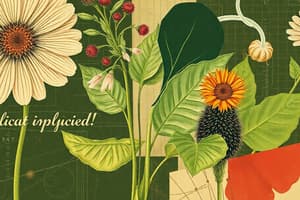Podcast
Questions and Answers
What is the function of meristematic tissue?
What is the function of meristematic tissue?
Responsible for plant growth
What is the function of apical meristematic tissue?
What is the function of apical meristematic tissue?
Begins the growth of new cells in young seedlings, affecting height and length.
What is the function of spherical cells?
What is the function of spherical cells?
Allows close packing of many cells.
What is the function of absent or small vacuoles in meristematic cells?
What is the function of absent or small vacuoles in meristematic cells?
Which of the following are complex tissues?
Which of the following are complex tissues?
What is cellular differentiation?
What is cellular differentiation?
Describe epidermis tissue.
Describe epidermis tissue.
Describe parenchyma tissue.
Describe parenchyma tissue.
What are stomata?
What are stomata?
What does Xylem tissue include?
What does Xylem tissue include?
What is the function of xylem tissue?
What is the function of xylem tissue?
Describe xylem vessels.
Describe xylem vessels.
What is the function of tracheids?
What is the function of tracheids?
What is phloem tissue made up of?
What is phloem tissue made up of?
What is an organ?
What is an organ?
What is the function of absent/small vacuoles?
What is the function of absent/small vacuoles?
What tissues are included as complex tissues?
What tissues are included as complex tissues?
What are xylem vessels?
What are xylem vessels?
What are tracheids?
What are tracheids?
What function do absent or small vacuoles have?
What function do absent or small vacuoles have?
What tissues do complex tissues include?
What tissues do complex tissues include?
What is xylem tissue?
What is xylem tissue?
Flashcards
Meristematic Tissue
Meristematic Tissue
Responsible for plant growth through cell division.
Apical Meristematic Tissue
Apical Meristematic Tissue
Located at the tips of stems and roots; responsible for primary growth (length).
Lateral Meristematic Tissue
Lateral Meristematic Tissue
Found in woody plants, responsible for secondary growth (thickness). Example: vascular cambium
Spherical Cells Function
Spherical Cells Function
Signup and view all the flashcards
Absent/Small Vacuoles Function
Absent/Small Vacuoles Function
Signup and view all the flashcards
Complex Tissues Include
Complex Tissues Include
Signup and view all the flashcards
Cellular Differentiation
Cellular Differentiation
Signup and view all the flashcards
Epidermis Tissue
Epidermis Tissue
Signup and view all the flashcards
Parenchyma Tissue
Parenchyma Tissue
Signup and view all the flashcards
Collenchyma Tissue
Collenchyma Tissue
Signup and view all the flashcards
Stomata
Stomata
Signup and view all the flashcards
Xylem Tissue Includes
Xylem Tissue Includes
Signup and view all the flashcards
Xylem Tissue
Xylem Tissue
Signup and view all the flashcards
Xylem Vessels
Xylem Vessels
Signup and view all the flashcards
Tracheids
Tracheids
Signup and view all the flashcards
Phloem Tissue
Phloem Tissue
Signup and view all the flashcards
What is Phloem Tissue Made Of
What is Phloem Tissue Made Of
Signup and view all the flashcards
Organ
Organ
Signup and view all the flashcards
Study Notes
- Plant tissues are responsible for growth and have specialized cells.
Meristematic Tissue
- This tissue type is responsible for plant growth.
Apical Meristematic Tissue
- This tissue initiates new cell growth in young seedlings, determining height and length.
Lateral Meristematic Tissue
- This tissue thickens woody trees, including the vascular cambium.
Spherical Cells
- They are closely packed together.
Absent/Small Vacuoles
- They prevent rapid division by providing rigidity.
Complex Tissues
- These include xylem and phloem.
Cellular Differentiation
- This process creates specialized cells.
Epidermis Tissue
- It is transparent and wax-covered, forming the outermost protective layer of the plant.
Parenchyma Tissue
- The main photosynthetic cells of leaves.
- It stores nutrients in roots and is the most common ground tissue.
Collenchyma Tissue
- It contains elongated living cells with irregular thick walls for support.
- This tissue is strong but flexible, and its division replaces damaged cells.
Stomata
- Pores in the epidermis of leaves and stems that are surrounded by guard cells, facilitating gas exchange.
Xylem Tissue
- It includes tracheids, vessels, and fibers.
- It transports water and minerals from the roots to the leaves for photosynthesis.
Xylem Vessels
- These are chained tubes with lignified side walls, hollow for water transport from root to leaf.
Tracheids
- They transport water and provide support.
- They consist of long, thin cells with tapered ends and lignin-hardened walls.
Phloem Tissue
- It transports glucose and other dissolved sugars from the leaves to other parts of the plant.
Phloem Tissue Composition
- It consists of sieve elements for transport.
- Parenchyma cells store food.
- Companion cells provide energy, alongside fibers.
Organ
- A group of tissues that work together to perform specific functions.
Studying That Suits You
Use AI to generate personalized quizzes and flashcards to suit your learning preferences.




